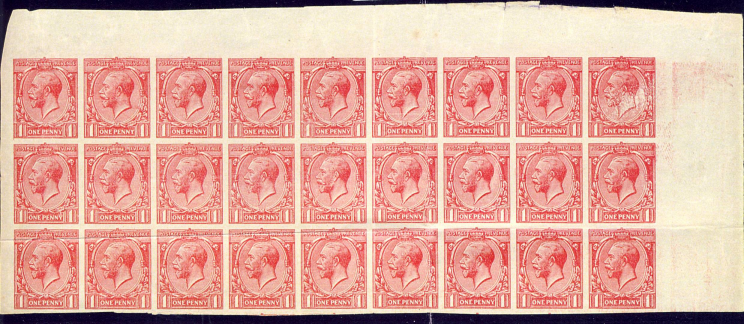Early in 2001 a block of 27 1d George V profile head stamps, consisting of the top three rows from a sheet nine stamps across with margins on 3 sides appeared on the philatelic market. These were imperforate, on un-gummed, un-watermarked paper and originally contained within an envelope marked on the outside 'Not to pass out of Mr Joynson's hands' (Joynson's were the supplies of paper used for the low value George V stamps for many years).

I first became interested in these stamps when I was asked if I knew of any printing which would use a plate 9 stamps across. As a keen coil collector, I realised immediately that these were probably from a coil printing, which originally used two plates 9 x 10 (ie 180 set) separated by a gutter margin 2 stamps wide. Having subsequently seen specimens of the stamps, I came to the conclusion that these were typical of the stamps produced at Somerset House, which culminated in the issue of E rolls in 1921 as SG N17a.
The original plate No 2/338 issued to Somerset House in 1913 was 200 set (20 across by 10 down) but on 13 April 1920 it was cut into three pieces - 90, 90 and 20 set. The two 90 set pieces made up the standard 180 set plate. This 180 set plate was used by Somerset House for all their subsequent printings and for the issued E rolls. The 20 set piece does not seem to have been used, although Somerset House retained it for some years. The printing must therefore have been made after this date.
By April 1921 Somerset House were able to report that 'the difficulty about the surface of the paper has been overcome' and that they should now be able 'to manufacture some satisfactory rolls of stamps' so it seems likely the block was printed prior to this date.
Why were Somerset House using un-watermarked un-gummed paper? Watermarked paper was expensive so Mr Patient (the Superintendent of the Engineering Branch of the Stamping Department at Somerset House who conducted the original experiments) did his first work on ordinary paper - this was different to the watermarked paper as it was made of esparto and had a high finish. The normal sheet paper had an insufficiently good surface and had to be given a higher finish to be of use.
To print stamps, even on un-watermarked paper, a Warrant would have been necessary and no Warrant has yet been traced which would fit this printing. However between the above dates, several warrants were issued to print on watermarked paper and it seems possible the first test under one of these Warrants was on the un-watermarked paper, examples of which were sent to Mr Joynson to show the progress, or lack of it, that had been made. I think therefore that these stamps are from an experimental printing but are not paper trials as such.
Subsequently, following the closure of the Grover factory, some of their archive material became available for study. Amongst this was the work sheet (MP102/91) for the original perforator made for Somerset House dated 7 November 1913, which also showed the changes made in the early 1920s for perforating the continuously printed E rolls, SG N17A. In addition the metal master plate also exists, although this is in the state after the 1920s alterations, when it had been converted to perforate two panes each of 9 stamps across with a central margin two stamps wide.